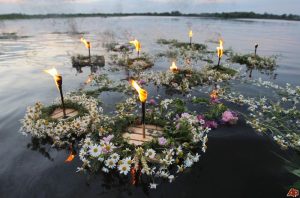
Wreaths on a river on Kupala Day.
Kupala was the female personification of the Slavic deity Kupalo, who was the god of peace, magic water and herbs. Alongside this, he was also one aspect of a fertility deity. Like other Slavic deities, Kupala and Kupalo were considered to be divine twins whose effigies would be burnt together to enhance a ritual. As his twin, Kupala was believed to be the goddess of water, fire, herbs and fertility throughout eastern Europe.
She was thought of as a goddess of the Summer Solstice, whose name literally derived meant “to bathe”. Her worshippers would bathe in rivers and dew that had been gathered in June in her honour. In both Russia and Ukraine, she was celebrated with a summer ritual where both young men and women would jump over a bonfire. While doing so, they would drag a maiden made of straw behind them. Since fire was believed to have the same purification aspects to it as water, it was believed that the maiden was being cleansed of its evil by members of the village. The next day everyone would bathe the figure in a local river and would then release it downstream. The festival was believed to represent evil being expelled from the village, in the name of Kupala. Similar images were also created in Serbia and other Slavic countries. Here, the image was dressed in a fine gown, decked with floral garlands and hung from a tree. The tree was required to have its upper branches trimmed, so that it formed the image of a green haired woman. Only women were able to perform this ritual and as such, men were forbidden to touch the image.
In all areas of eastern Europe, Kupala was believed to be the deity of both herbs and ferns. Purple-loosestrife was considered to be her favourite, as its flowers blossomed between June and August. Traditionally it was believed to have the power to banish demons if gathered at dawn on the Summer Solstice. This again ties Kupala to the protection of a village and the banishment of evil. As her sacred plant was believed to have been a fern, several were thought to have granted its possessor to understand the language of the trees.
By 1835, Christianity had been the dominant religion in Europe for over a thousand years, with St John the Baptist taking on many of the traditional aspects of Kupala. St John, also known as Ivan, had a celebrated festival around the time of the summer solstice. However, as noted in the Deutsche Mythologie by Jacob Grimm, the word ‘Kupala’ was still used to describe bonfires lit at the time of the Summer Solstice in Russia. Kupala Night, which is also known as Ivan Kupala Day, is still celebrated on approximately the 6th July each year. This equates to roughly the 23rd June on the traditional calendar, which is still used by many Orthodox Church churches. Early scholars, such as Sir James Frazer, argued that the holiday was the original pagan fertility rite that had become adopted into the Orthodox Church. This was due to its popularity throughout all areas of eastern Europe. However, some believe it takes the name of ‘Kupala’ from the bonfire aspect or ‘Kupala’ to mean bathing. However, it is also argued that the bathing aspect takes its name from the bathing in a baptism. During a modern Kupala Day, young people jump over a bonfire in a test of faith and bravery. Other regions such as Ukraine, do so in a belief that it cleanses ill fortune, as is seen in the original festival for the deity Kupala. Girls float wreaths of flowers and candles in the river in order to visualise their relationship prospects for the coming year. Men can attempt to catch one of these wreaths in some areas, in a show of interest in someone. Women also traditionally wear garlands and wreaths on this day in an observance of the Summer Solstice, much like would have been worn in the traditional Kupala festival.
-Devon Allen
Junior Girl
Girl Museum Inc.
